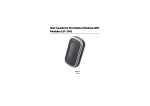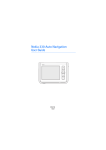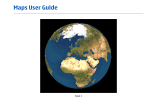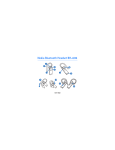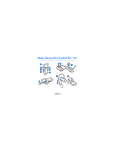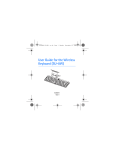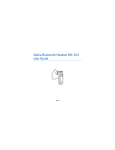Download Mobile Crossing BLUETOOTH GPS User guide
Transcript
Nokia Wireless GPS Module LD-3W User Guide 9246134/1 ENGLISH DECLARATION OF CONFORMITY We, NOKIA CORPORATION, declare under our sole responsibility that the product LD-3W is in conformity with the provisions of the following Council Directive: 1999/5/EC. A copy of the Declaration of Conformity can be found from http://www.nokia.com/phones/ declaration_of_conformity/. The crossed-out wheeled bin means that within the European Union the product must be taken to separate collection at the product end-of-life. Do not dispose of these products as unsorted municipal waste. Copyright © 2006 Nokia. All rights reserved. Reproduction, transfer, distribution or storage of part or all of the contents in this document in any form without the prior written permission of Nokia is prohibited. Nokia is a registered trademark of Nokia Corporation. Other product and company names mentioned herein may be trademarks or tradenames of their respective owners. Bluetooth is a registered trademark of Bluetooth SIG, Inc. Nokia operates a policy of continuous development. Nokia reserves the right to make changes and improvements to any of the products described in this document without prior notice. Under no circumstances shall Nokia be responsible for any loss of data or income or any special, incidental, consequential or indirect damages howsoever caused. The contents of this document are provided "as is". Except as required by applicable law, no warranties of any kind, either expressed or implied, including, but not limited to, the implied warranties of merchantability and fitness for a particular purpose, are made in relation to the accuracy, reliability or contents of this document. Nokia reserves the right to revise this document or withdraw it at any time without prior notice. ENGLISH The availability of particular products may vary by region. Please check with the Nokia dealer nearest to you. Export Controls This device may contain commodities, technology or software subject to export laws and regulations from the US and other countries. Diversion contrary to law is prohibited. For your safety Read these simple guidelines. Not following them may be dangerous or illegal. Read the complete user guide for further information. Interference All wireless devices may be susceptible to interference, which could affect performance. Batteries and chargers Use only approved batteries and chargers. Do not connect incompatible products. Connecting to other devices When connecting to any other device, read its user guide for detailed safety instructions. Do not connect incompatible products. Qualified service Only qualified personnel may repair this device. Introduction With the Nokia Wireless GPS Module, you can determine your current position and direction easily. The GPS module is a battery-operated device that uses Bluetooth wireless technology to communicate positioning information to ENGLISH compatible mobile phones, PCs, PDAs, and other devices. To use the GPS module, you need a compatible software application on the device that you connect to it. Read this user guide carefully before using the GPS module. Check also http:// www.nokia.com/support or your local Nokia Web site for the latest version of this guide, additional information, downloads, and services related to your Nokia product. Global positioning system (GPS) The GPS (global positioning system) is a worldwide satellite-based radio navigation system. A GPS terminal can calculate its location to an accuracy of 10 meters. The accuracy depends on the number of satellites, the signals of which the GPS module receives. In optimal conditions, the accuracy may be within a few meters. The antenna of the GPS module is located under the Nokia logo, and it should face upwards. Some car windshields and windows may contain metal, which may block or weaken the satellite signals. If you stand still, GPS cannot detect which way you are facing, because it determines your direction on the basis of your movement. Note: The GPS (global positioning system) is operated by the United States government, which is solely responsible for accuracy and maintenance of the system. The accuracy of location data can be affected by adjustments to GPS satellites made by the United States government and is subject to change with the United States Department of Defense civil GPS policy and the Federal Radionavigation Plan. Accuracy can also be affected by poor satellite geometry. Availability and quality of GPS signals may be affected by buildings and natural obstacles, as well as weather conditions. The GPS receiver should only be used outdoors to allow reception of GPS signals. GPS should not be used for precise location measurement, and you should never rely solely on location data from the GPS receiver. This GPS receiver does not ENGLISH support location of the phone by emergency operators. Get started Your device may contain small parts. Keep them out of reach of small children. Before you can start to use the GPS module, you must do the following: • Install a compatible software application on the phone. • Charge the battery of the GPS module fully. • Pair the compatible phone with the GPS module. Some Nokia phone models, such as the Nokia 9500 Communicator, have a location privacy setting. To provide GPS location data to software applications in the Nokia 9500 Communicator, select Tools → Control panel → Extras → Location privacy → Verification policy → Accept all. GPS module parts The GPS module contains the following parts shown in Figure 1 at the start of this guide: 1 - GPS indicator light 2 - Bluetooth indicator light 3 - Battery charge indicator light 4 - Power key 5 - Release button of the back cover 6 - Charger connector Batteries and chargers The GPS module has a removable and rechargeable BL-5C battery. For availability of approved batteries and chargers, check with your local dealer. Check the model number of any charger before use with this device. This device is intended for use when supplied with power from the AC-3, AC-4, and DC-4 chargers. ENGLISH Warning! Use only batteries and chargers approved by Nokia for use with this particular device. The use of any other types may invalidate any approval or warranty, and may be dangerous. When you disconnect the power cord of any enhancement, grasp and pull the plug, not the cord. Install the battery See Figure 2 at the start of this guide. 1. To open the back cover of the GPS module, press the release button (1), and slide the cover away from the device (2). 2. Insert the battery (3). 3. Close the back cover (4), and slide it in the direction of the arrow (5) until it locks into place. Charge the battery 1. Plug the charger into its connector on the GPS module. 2. Connect the charger to a power outlet. During charging, the green or red indicator light blinks, depending on whether the GPS module is on (green) or off (red). When the battery is fully charged and the power is on, the green light is displayed continuously. When the battery is fully charged and the power is off, the red light stops to blink. 3. Disconnect the charger from the power outlet and the GPS module. When the battery is running out of power, the red indicator light on the GPS module starts to blink every 15 seconds. Recharge the battery. Basic use The GPS module should only be used outdoors to allow reception of GPS signals. GPS should not be used for precise location measurement, and you should never rely solely on location data from the ENGLISH GPS module. Almost all digital cartography is inaccurate and incomplete to some extent. Never rely solely on the cartography provided for use with this device. The use of this GPS module requires your mobile phone to be switched on. Do not switch on your mobile phone where it may cause interference or danger. Switch the GPS module on and off To switch the GPS module on or off, press the power key for one second. When you turn on the GPS module, it takes some time for the device to position itself, depending on how long the GPS module has been turned off, and how well it can receive the satellite signals. The start-up time is also longer if the battery has been removed. In optimal conditions, the start-up takes about one minute. Connect with Bluetooth wireless technology There may be restrictions on using Bluetooth technology in some locations. Check with your local authorities or service provider. See the user guide of your phone for a more detailed description of Bluetooth wireless technology. Pair with a compatible phone Before you can use the GPS module, you must pair it with a compatible phone. With some GPS applications, you can pair and connect the GPS module within the application without using the Bluetooth menu of your phone. See the user guide of the GPS application. If you have previously connected other GPS devices to your phone, remove their pairings from the phone before pairing the GPS module. To pair the GPS module in the Bluetooth menu: 1. Make sure the phone and the GPS module are switched on. 2. Switch on the Bluetooth feature in your phone, and set the phone to search for Bluetooth devices as instructed in the user guide of the phone. 3. Select the GPS module (Nokia LD-3W) from the list of found devices. 4. Enter the Bluetooth passcode 0000 to pair the GPS module with the phone. ENGLISH 5. Start using the GPS application. You can pair the GPS module with up to eight compatible phones, but you can connect it to only one at a time. Disconnect the GPS module To disconnect the GPS module, do one of the following: • Disconnect the GPS module in the application that you used to establish the connection. • Switch off the GPS module. • Disconnect the GPS module in the Bluetooth menu of the phone. Check the GPS module status in the night mode In some GPS applications, you can set the GPS module into the night mode. In the night mode, the indicator lights are only lit if the GPS module cannot determine its position, or if the Bluetooth connection is lost. To check the GPS module status in the night mode, press the power key quickly. The indicator lights appear briefly. Support for WAAS/EGNOS The GPS module supports the WAAS/ EGNOS system. To use the system, your GPS application needs to support it as well. For details, see the user guide for your GPS application. Reset the GPS module To reset the GPS module, press the power key for 10 seconds. During resetting, the green and red indicator lights blink alternately. Troubleshooting If you cannot connect the GPS module to a compatible phone, proceed as follows: • Ensure that the Bluetooth feature is activated on the compatible phone. • Ensure that the GPS module is switched on and paired with a compatible phone. • Ensure that you ended the previous Bluetooth connection from the phone. • Check that the GPS module is within 10 meters of the phone and that there are no obstructions or electronic devices between the two. ENGLISH Battery information • Your GPS module is powered by a rechargeable battery. The full performance of a new battery is achieved only after two or three complete charge and discharge cycles. The battery can be charged and discharged hundreds of times, but it will eventually wear out. When the talk and standby times are noticeably shorter than normal, replace the battery. Use only Nokia approved batteries, and recharge your battery only with Nokia approved chargers designated for this device. • Unplug the charger from the electrical plug and the device when not in use. Do not leave a fully charged battery connected to a charger, since overcharging may shorten its lifetime. If left unused, a fully charged battery will lose its charge over time. • Use the battery only for its intended purpose. Never use any charger or battery that is damaged. • Do not short-circuit the battery. Accidental short-circuiting can occur when a metallic object, such as a coin, a clip or a pen, causes direct connection of the positive (+) and negative (-) terminals of the battery. (These look like metal strips on the battery.) This might happen, for example, when you carry a spare battery in your pocket or purse. Shortcircuiting the terminals may damage the battery or the connecting object. • Leaving the battery in hot or cold places, such as in a closed car in summer or winter conditions, will reduce the capacity and lifetime of the battery. Always try to keep the battery between 15°C and 25°C (59°F and 77°F). A device with a hot or cold battery may not work temporarily, even when the battery is fully charged. Battery performance is particularly limited in temperatures well below freezing. ENGLISH • Do not dispose of batteries in a fire as they may explode. Batteries may also explode if damaged. Dispose of batteries according to local regulations. Please recycle when possible. Do not dispose as household waste. Care and maintenance Your GPS module is a product of superior design and craftsmanship and should be treated with care. The suggestions below will help you protect your warranty coverage. • Do not use or store the GPS module in dusty, dirty areas. Its moving parts and electronic components can be damaged. • Do not store the GPS module in hot areas. High temperatures can shorten the life of electronic devices, damage batteries, and warp or melt certain plastics. • Do not store the GPS module in cold areas. When the device returns to its normal temperature, moisture can form inside the device and damage electronic circuit boards. • Do not attempt to open the GPS module other than as instructed in this guide. • Do not drop, knock, or shake the GPS module. Rough handling can break internal circuit boards and fine mechanics. • Do not use harsh chemicals, cleaning solvents, or strong detergents to clean the GPS module. • Do not paint the GPS module. Paint can clog the moving parts and prevent proper operation. If the GPS module is not working properly, take it to the nearest authorized service facility for service.











